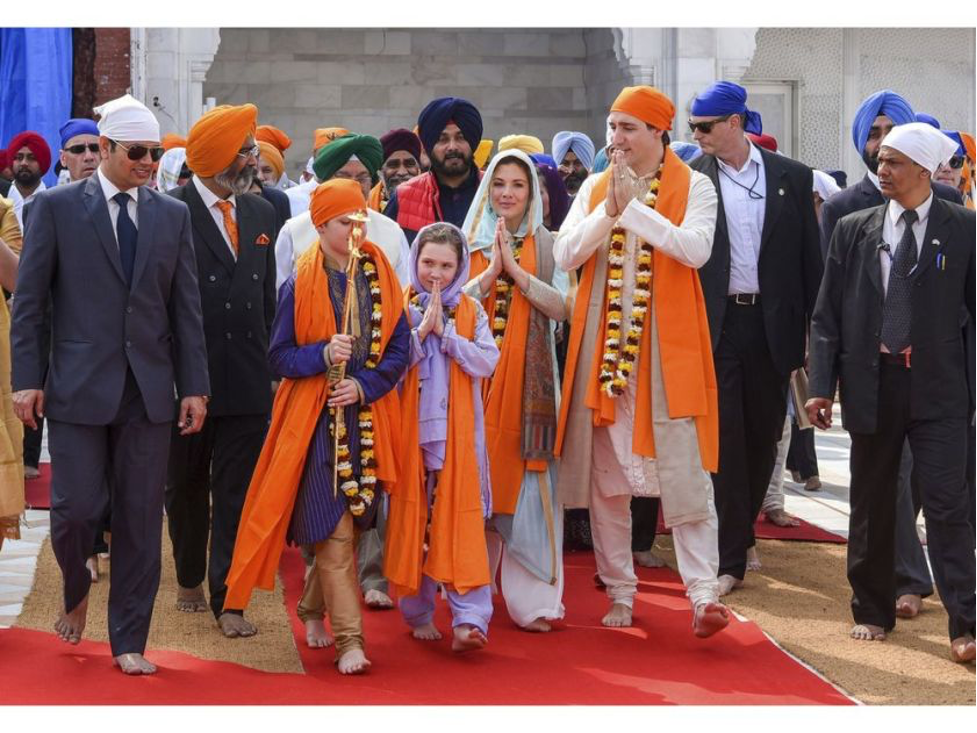Justin Trudeau is the Prime Minister of Canada and recently a controversial figure in media. He has a habit of wearing the national clothing of the host nation when visiting. This is often seen as insensitive or offensive by commenters. However, multiple photographs of him are available from such visits, offering an exciting opportunity to examine the images’ representation. This essay will discuss one photo from Trudeau’s 2018 visit to India and conduct a textual analysis of it.
Description and Analysis
The photograph, taken in broad daylight, depicts Trudeau himself, walking alongside his family, all in the Añjali Mudrā posture, which is a part of an Indian greeting and expression of respect, namaste. They are wearing brightly-colored costumes in an ethnic Indian style. Alongside them, there are four other people: Westerners, likely bodyguards, wearing strict suits and ties, and also headscarves or bandannas. Several local men are present in the picture, as well; most of them are obscured by those standing in front. Some of those visible are wearing formal suits, while others (partially covered) seem to be wearing traditional clothes; all of them wear turbans.

The image’s central focus is the prime-ministerial family themselves and their choice of clothes. It highlights the distinction between “us” and “them,” expected to Orientalism, between vastly different cultures (Said, 1995). The intended signified is likely the bridging of this cultural gap, but it is undermined, and perhaps even inverted, by the contrast with the locals and bodyguards’ suits, obviously part of the Occidental culture.
The hand gestures three of the four are displaying are a traditional Indian expression of greetings and respect, a commonly recognizable part of the Indian tradition. These signs, when taken together, can be interpreted as connotations of a degree of Indianicity, concepts that English-speaking Canadians are likely to associate with the idea of India (Barthes, 1977; Hall, 1997). They intend to show Trudeau as understanding and partaking of the culture, though not necessarily belonging to it.
Another set of signifiers can be obtained from the relative spatial positions of the people in the image. The Trudeaus are standing in front of the locals, obscuring them from view. Once again referencing Orientalism and its perceived distinction into the East and the West, this position presents them as having a “relative upper hand” (Said, 1995, p. 90). However, an alternative — and, possibly, more charitable — interpretation is protecting, leading, or representing others. In either case, this interpretation still carries the connotation of superiority, not just the ability to take on those roles, but a desire to do so whether the other needs or wants it or not.
The bodyguards’ presence and tense expressions, though doubtlessly prescribed by procedure, bears further negative connotations. The scene is presented as peaceful and safe: The Prime Minister’s family is smiling, everyone else’s expressions are calm or neutral, and no signs of danger are evident. However, the presence and body language of the bodyguards can be inferred to mean distrust in the hosts’ hospitality or ability to ensure safety.
Conclusion
The analysis of the photograph revealed connotations of distrust, superiority, and cultural divide. This is, by its nature, a subjective and, to an extent, purposefully negative reading of its content. It highlights that a person’s, particularly a public figure’s, the image can depend on a variety of interpretations of photographs, possibly taken out of context. Therefore, when presenting themselves, one should take care to minimize the potential for such misinterpretations.
References
Barthes, R. (1992). The rhetoric of the image. (S. Heath, Trans.). New York, NY: The Noonday Press. (Original work published 1977).
Hall, S. (1997). The work of representation. In S. Hall (Ed.), Representation: Cultural Representations and Signifying Practices (pp. 13-74)
Said, E. W. (1995). Orientalism. In B. Ashcroft, G. Griffiths, & H. Tiffin (Eds.), The Post-Colonial Studies Reader (pp. 87-91). New York, NY: Routledge.